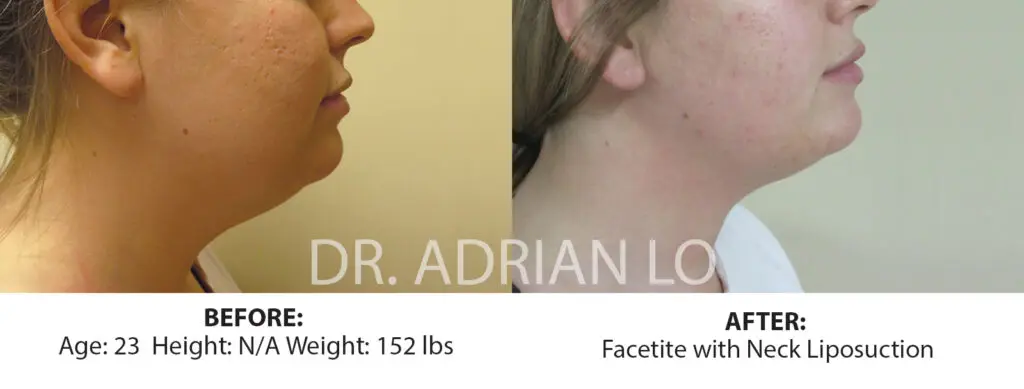If you’re tired of feeling self-conscious about sagging skin and unwanted fat, you might have already considered plastic surgery.
But if you’re here, then you’ve probably stumbled upon the less invasive alternative, the FaceTite procedure. Here’s what you can expect from FaceTite!
What is a FaceTite Procedure?

A FaceTite procedure is a cosmetic procedure that can help you achieve a more youthful appearance without the need for major surgery. This minimally invasive treatment uses radiofrequency energy to gently heat the skin and tissues beneath it, which can tighten skin and melt away unwanted fat.
This heat also triggers your body’s natural healing response, encouraging the production of collagen, a protein that gives skin its strength and elasticity. The process results in a more toned and refreshed look with minimal downtime, making it a popular alternative to a traditional facelift.
If you’re bothered by sagging skin, jowls, or wrinkles around your lower face and neck, the FaceTite procedure could be a great option for you!
Preparing For Your Facetite Procedure

Before you undergo a FaceTite procedure, it’s important to have a consultation with a qualified plastic surgeon.
This is a chance for you to discuss your goals and expectations, for the plastic surgeon to evaluate your suitability for the procedure, as well as for you to understand the cost of a FaceTite procedure. Be sure to share your full medical history, including any medications you are taking and any allergies you have.
Your plastic surgeon may give you specific instructions to follow before the procedure, like avoiding certain medications or supplements. They may also advise you on how to prepare for your recovery at home, such as arranging for transportation and gathering any supplies you might need.
The Facetite Procedure

Consultation
So, you’ve decided to explore FaceTite! The first step is a relaxed conversation with your plastic surgeon.. This is your chance to share what you’re hoping to get out of the procedure, whether it’s tighter skin, less noticeable wrinkles, or a more defined jawline.
Your plastic surgeon will listen carefully, examine your face and neck, and discuss with you whether FaceTite is a good fit for you. This is also the time to ask any questions you have and to go over the final FaceTite procedure cost.
Preparation
On the day of your FaceTite procedure, you’ll be made comfortable in a treatment room. Before things get started, your skin will be cleaned and prepared. If you’re a bit nervous, don’t worry – a qualified plastic surgeon will discuss different options for numbing the area so you’re comfortable during the procedure.
You might have a choice between a local anesthetic, which numbs just the treatment area, or a light sedative to help you relax during the process.
Anesthesia
If you choose local anesthesia, a numbing medication will be injected directly into the treatment areas to ensure your comfort throughout the FaceTite procedure. This means you’ll be awake and alert but won’t feel any pain in the areas being treated. Some people prefer local anesthesia because it involves fewer risks and allows for a quicker recovery.
For those who prefer a deeper level of relaxation, a light sedative might be a better option. This is usually administered through an IV, and it will make you feel very relaxed, possibly even a little sleepy. Depending on the extent of the procedure and your preferences, your plastic surgeon might recommend combining local anesthesia with a sedative for optimal comfort.
In some cases, general anesthesia may also be an option, although it is less commonly used for FaceTite procedures.
Incision
To start the FaceTite procedure, your plastic surgeon will make a few very small incisions, typically no larger than a few millimeters. These incisions are strategically placed in areas where they will be the least noticeable, often hidden in natural creases or folds of skin. Common incision sites include behind your ears, along your hairline, or under your chin.
The number and placement of these incisions will vary depending on your individual treatment plan and the specific areas being targeted. Rest assured, these incisions are designed to heal quickly and discreetly, with minimal scarring. The goal is to enhance your natural beauty, not detract from it.
Once these tiny incisions have been made, your plastic surgeon can proceed with the next steps of the FaceTite procedure, using a specialized handpiece to deliver radiofrequency energy and achieve those desired skin tightening and fat reduction effects.
RF Energy Application
Once the incisions are made, a thin tube called a cannula will be inserted under your skin. This cannula delivers radiofrequency energy, which is a type of heat, to the areas that need tightening or fat reduction.
The radiofrequency energy works its magic by gently heating up the tissues, causing them to contract and tighten. It also helps to melt away unwanted fat cells, which are then naturally removed by your body over time.
Tissue Heating
Now that the radiofrequency energy is in place, it’s time for the magic to happen! The energy gently heats up the deeper layers of your skin, which does two things:
First, it’ll kickstart the production of collagen, the protein that gives your skin that youthful bounce and firmness. Then, it’ll help to remodel the tissues, encouraging them to tighten and become more sculpted. This double-action process is what leads to the natural-looking results that FaceTite is known for.
Contouring
While the radiofrequency energy is working, your plastic surgeon will be carefully sculpting your face and neck to create a smooth, refined look. This step is all about artistry and precision, ensuring that the final outcome aligns with your unique facial structure and desired results.
By gently manipulating the tissues, your plastic surgeon will essentially enhance your natural contours, reduce any sagging or jowls, and create a more youthful, lifted appearance.
Closure
Once the sculpting and contouring phase of your FaceTite procedure is finished, your plastic surgeon will focus on closing the small entry points that were made at the beginning of the procedure. These incisions are typically quite small and strategically placed in discrete areas, such as behind your ears, within your hairline or underneath your chin.
Depending on the location and size of the incisions, your plastic surgeon may use either very fine, dissolvable sutures that are naturally absorbed by your body or special adhesive strips to gently hold the edges of the skin together while it heals.
FaceTite is designed to be a minimally invasive procedure, and these tiny incisions are meant to heal with minimal visibility. In most cases, any remaining marks will fade over time, leaving you with a refreshed and rejuvenated appearance.
Recovery
Most people can return to their usual activities within a couple of days, but it’s important to take it easy and avoid strenuous activity for a week or two. You might experience some swelling and bruising, which is totally normal and usually subsides within a few days to a week. Think of it like your skin’s way of saying it’s working hard to heal and rejuvenate.
To help manage the swelling and make yourself more comfortable, your plastic surgeon might recommend wearing a compression garment for a short period.
As far as results, you’ll probably notice some initial improvement right away, but the full effects of FaceTite gradually unfold over several weeks and months as your body produces new collagen and your skin continues to tighten. (It’s a bit like watching a flower bloom – slow and steady, but the final result is worth it.)
What to Expect From Your Results

One of the most exciting aspects of FaceTite is seeing your results gradually develop and improve over time. While you may notice some subtle changes right away, the most dramatic improvement usually takes a few weeks to a few months as your skin continues to tighten and your body produces new collagen.
Taking some FaceTite procedure before and after pictures is also a great way to help you keep track of the transformation!
FaceTite results can also be long-lasting! By taking care of your skin, maintaining a healthy lifestyle, and protecting yourself from the sun, you can enjoy your refreshed look for years to come.
Love Your Face Again With Dr. Adrian Lo!
Still wondering “What is a FaceTite procedure?” Dr. Lo is a renowned expert in facial rejuvenation procedures, with a passion for helping his patients achieve their aesthetic goals.
We know that every face is unique, and take the time to get to know each of our patients on a personal level, developing customized treatment plans that cater to their individual needs.
If you’re ready to take the first step towards a more youthful, refreshed you, schedule a consultation with Dr. Lo today. We’ll be happy to answer any questions you have and create a personalized plan to help you love the skin you’re in!
